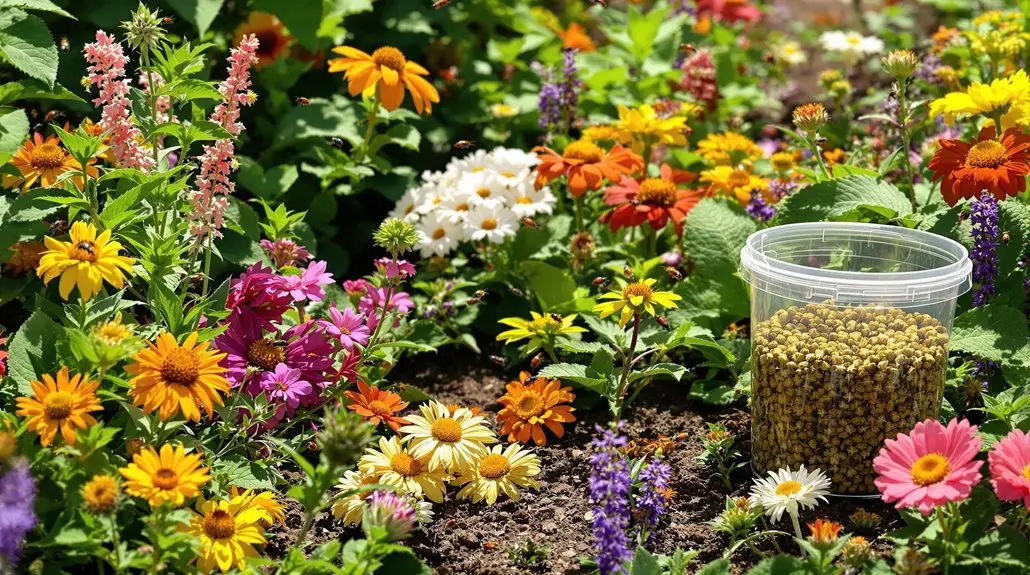If you’re looking to implement IPM biological control in your South Florida landscape, you’re in good hands. Proven studies show that using natural predators like ladybugs and dragonflies effectively reduces pest populations. Focusing on cultural practices, such as selecting pest-resistant plants and promoting biodiversity, also plays a significant role. Regular monitoring and incorporating beneficial organisms create a robust ecosystem that supports plant health. Habitat features, like water sources and leaf litter, further enhance natural pest management. Discover how these strategies can transform your landscape into a thriving, sustainable oasis that benefits both your garden and the environment.
Key Insights
- Integrated Pest Management (IPM) in South Florida emphasizes monitoring and cultural practices to minimize pest populations sustainably and effectively.
- Successful case studies highlight the role of beneficial insects like ladybugs and parasitic wasps in reducing pest populations in residential landscapes.
- Incorporating native plants in gardens fosters biodiversity, attracting natural enemies and enhancing biological pest control in South Florida.
- Educational resources from institutions like the University of Florida provide proven strategies for implementing IPM and biological control in residential settings.
- Community engagement in pest management initiatives promotes shared knowledge and sustainable landscaping practices, leading to healthier ecosystems in South Florida.
Understanding Biological Control

Biological control is all about harnessing nature to manage pest populations effectively. When you embrace this method, you’re not just tackling pests; you’re creating a healthier environment for everyone in your community. The primary goal of biological control is to prevent or reduce pest populations to levels that won’t harm your plants or landscape. By doing this, you contribute to a more sustainable ecosystem that benefits both you and your neighbors. One of the remarkable aspects of biological control is its ability to delay pest outbreaks. This gives you the chance to implement other management strategies without feeling overwhelmed. By maintaining ecosystem balance, you’re allowing natural enemies—like beneficial insects—to regulate pest populations, which minimizes the need for chemical pesticides. This shift not only protects your health but also the environment. Implementing biological control strategies, such as conservation and augmentation, empowers you to take action in your landscape. You can enhance existing natural enemies through simple changes in landscape management or introduce new ones to boost pest control. Notably, these biological control agents are effective for managing pests that are resistant to chemical controls. Additionally, companies like NaturePest focus on organic pest control methods that support sustainable practices. Whether it’s through habitat manipulation or reduced pesticide use, every step you take supports a thriving community of beneficial organisms.
Types of Natural Enemies
Natural enemies play an essential role in maintaining pest populations at manageable levels. By introducing various types of natural enemies into your garden, you can create a balanced ecosystem that supports healthy plants and minimizes pest damage.
Predatory insects like ladybugs and lacewings are fantastic allies, as they feast on soft-bodied pests like aphids and mealybugs. You can attract hoverflies by planting sweet alyssum, which not only enhances your garden’s beauty but also invites these beneficial predators. Integrated Pest Management emphasizes the use of these natural enemies as a sustainable approach to pest control.
Dragonflies are another great choice, as they help keep mosquito populations in check.
Parasitic insects also contribute greatly. Larra wasps target mole crickets, laying their eggs inside them, while Trichogramma wasps parasitize the eggs of caterpillars.
Aphidius wasps focus on aphids, further controlling their numbers. Don’t forget about tachinid flies and braconid wasps; they’re effective against a range of pests too.
Beneficial nematodes, those microscopic wonders, are another great option. They prey on insect larvae like termites without harming humans, pets, or beneficial insects, making them an eco-friendly choice for your yard.
Beyond insects, other natural enemies include spiders, ground beetles, toads, frogs, and certain bird species, all of which contribute to pest control.
Benefits of Biological Control
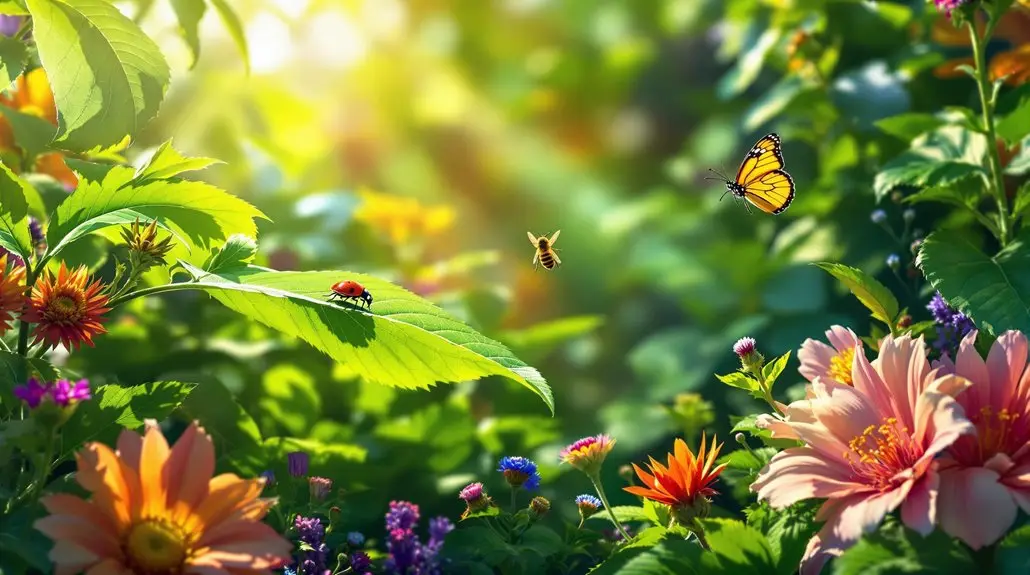
One of the most significant advantages of using biological control in your garden is the reduction of harmful chemical pesticides. By embracing these natural methods, you not only protect your plants but also contribute to a healthier environment. This approach minimizes your garden’s impact on local wildlife and habitats, allowing them to thrive without the threat of toxic chemicals. Additionally, NaturePest’s eco-friendly solutions can enhance the effectiveness of biological control methods.
Additionally, biological control helps maintain ecosystem balance by promoting natural predator-prey relationships. You’ll encourage a diverse range of beneficial organisms, which enhances biodiversity and creates a more resilient landscape. This diversity also mitigates the risk of pest populations developing resistance to pesticides—something that can be a costly and frustrating problem. Integrating multiple management tools can further enhance the effectiveness of biological control strategies.
Economically, you’ll find that investing in biological control can lead to long-term cost savings. By reducing the need for repetitive chemical treatments, you’ll save money and decrease the impact of pest damage on your plants.
Plus, using these sustainable practices can increase the value of your home, making it more appealing to potential buyers who appreciate eco-friendly solutions.
On a personal level, biological control promotes a healthier living environment for you and your pets by reducing exposure to toxic chemicals. It lowers the risk of pesticide-related illnesses and contributes to cleaner air, soil, and water in your community.
Implementing Effective Strategies
To effectively implement biological control strategies in your garden, start by closely monitoring your plants for any signs of pest activity. It’s crucial to scout your garden one to three times a week, looking for common signs of infestation like chewed leaves or discolored plant segments. Accurate identification of pests will help you choose the right control measures. Additionally, regular inspection of plants is necessary for tracking pest activity and understanding their lifecycle.
Here’s a quick reference table to help you organize your strategies:
| Strategy Type | Key Actions |
|---|---|
| Monitoring | Inspect plants regularly for pests |
| Cultural Practices | Use pest-resistant plants; rotate crops |
| Physical Controls | Handpick pests; use barriers |
| Biological Control | Release beneficial insects; promote predators |
Incorporating cultural practices is essential. Place your pest-resistant plants in suitable areas to meet their light and moisture needs. Avoid stressing your plants with excessive watering or fertilization. You can also enhance biodiversity by rotating crops and intercrop planting. Implementing eco-friendly practices can significantly enhance the health of your garden.
For physical controls, consider handpicking larger pests or using barriers to keep them out. Removing affected plant parts can greatly reduce pest populations.
Lastly, biological control methods can be remarkably effective. You might release ladybugs or lacewings to manage aphid populations or use nematodes to target termite larvae. By promoting beneficial insect populations through habitat enhancement, you’ll create a thriving ecosystem in your garden. Remember, every small action you take contributes to a healthier landscape.
Habitat Manipulation Techniques
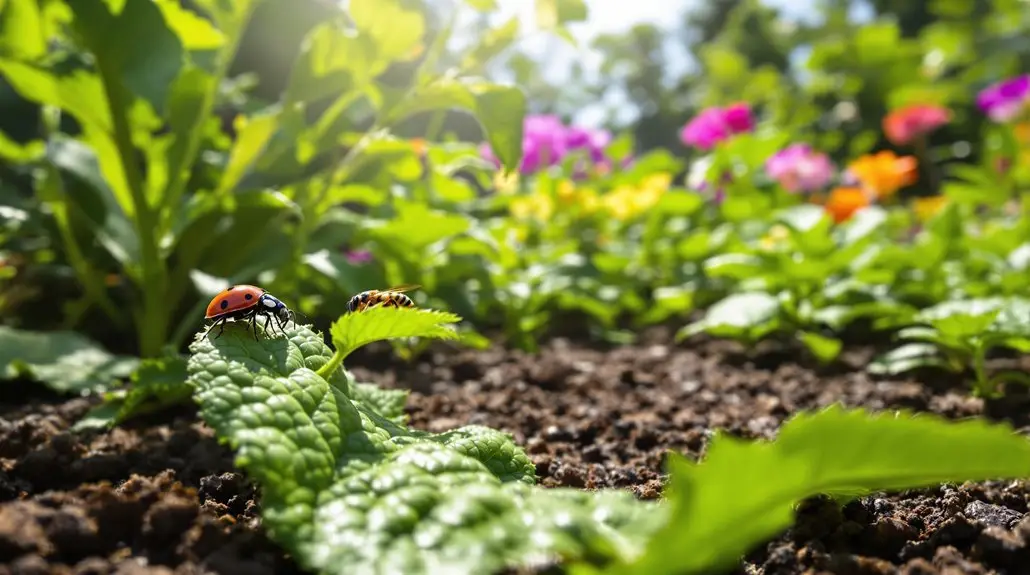
When you think about habitat manipulation techniques, consider how diverse plant selection can create a resilient ecosystem. By incorporating pest-resistant and native plants, you can attract beneficial insects that help control pests naturally. Additionally, implementing physical barriers can further protect your plants from unwanted invaders. This approach aligns with Integrated Pest Management (IPM), which emphasizes prevention and monitoring to reduce reliance on chemical solutions. Community awareness of these practices can significantly enhance the effectiveness of pest management efforts in residential landscapes.
Diverse Plant Selection
Diverse plant selection is key to creating a resilient ecosystem that naturally suppresses pests. By incorporating native plants into your landscape, you’ll benefit from their natural pest resistance, reducing your reliance on pesticides.
Opt for plants bred to withstand specific pests, as they can greatly decrease infestations, keeping your garden thriving. Additionally, the expertise of professionals in pest identification and treatment can enhance your understanding of which plants will best support your landscape’s health. In South Florida, understanding local pest issues is crucial for effective plant selection.
Mixing various plant structures, colors, and bloom times not only enhances aesthetics but also boosts biodiversity. This diversity supports a broader range of beneficial organisms, which play an essential role in natural pest control.
When you place your plants thoughtfully—considering their light, moisture, and soil needs—you’ll minimize stress and vulnerability to pests.
Also, embrace cultural practices like crop rotation or intercropping. These methods can disrupt pest populations and create a less hospitable environment for them.
Remember, maintaining a clean landscape and regularly inspecting your plants will help you catch issues before they escalate.
By fostering a diverse plant community, you’re fostering a supportive habitat for beneficial insects and pollinators, bringing your garden to life.
Together, we can build a vibrant ecosystem that’s both beautiful and resilient.
Beneficial Insect Habitats
Creating habitats for beneficial insects is fundamental for maintaining a healthy garden ecosystem. You can attract these helpful allies by planting insectary plants like white alyssum, basil, cilantro, and dill. These flowers provide essential pollen and nectar, ensuring a steady food source for beneficial insects. In particular, lacewings are known for their ability to consume pests like aphids and contribute significantly to natural pest control.
By incorporating a variety of plants with different structures, colors, and bloom times, you’ll support a diverse range of insects that contribute to your garden’s health.
To further enhance habitats, create undisturbed areas with leaf litter, brush, or logs for reproduction and winter hibernation. Maintaining a biodiverse landscape, including native plants, helps draw in beneficial insects more effectively than exotic varieties.
Remember to include water sources, as they’re important for drinking and reproduction.
Avoid excessive pruning and mowing, as these practices can diminish habitats. Instead, use natural substances like spinosad to protect insects while promoting their beneficial role.
Physical Barriers Implementation
Implementing physical barriers is an effective strategy for protecting your garden from pests while promoting a balanced ecosystem. You can create fine-mesh screens or fine-netting to keep troublesome insects away from your plants. Row covers are perfect for shielding your vegetables, and copper barriers can deter slugs and snails effortlessly. Additionally, sticky traps help capture those annoying flying insects, while exclusion fencing keeps larger critters like deer at bay. By using mechanical controls, you can directly remove or deter pests, enhancing the overall effectiveness of your pest management approach.
Here’s a simple table to help you visualize these options:
| Barrier Type | Purpose |
|---|---|
| Fine-Mesh Screens | Prevent insects from reaching plants |
| Row Covers | Shield vegetables from pests |
| Copper Barriers | Deter slugs and snails
Selecting Pest-Resistant Plants
Selecting pest-resistant plants is essential for maintaining a healthy landscape in South Florida. When you choose plants, consider their specific light, moisture, and soil needs to keep them thriving and stress-free.
Opt for native plants, as they’re generally better suited to local conditions, making them less susceptible to pests. Not only do they require less maintenance regarding watering and fertilization, but they also support beneficial insects that naturally control pest populations.
If you’re drawn to exotic varieties, look for those bred specifically for pest resistance. Think about how your selected plants will grow and how they’ll interact with each other in your garden.
Diversity is key—planting various species with different structures, colors, and bloom times will attract a broader range of beneficial organisms.
To encourage even more beneficial insects, consider incorporating plants that provide nectar and pollen. For example, intercropping vegetables with flowers like sweet alyssum can lure hoverflies, which prey on aphids.
Regularly inspect your plants for early signs of pest issues, and maintain good watering and fertilization practices to prevent stress.
Modifying Cultural Practices
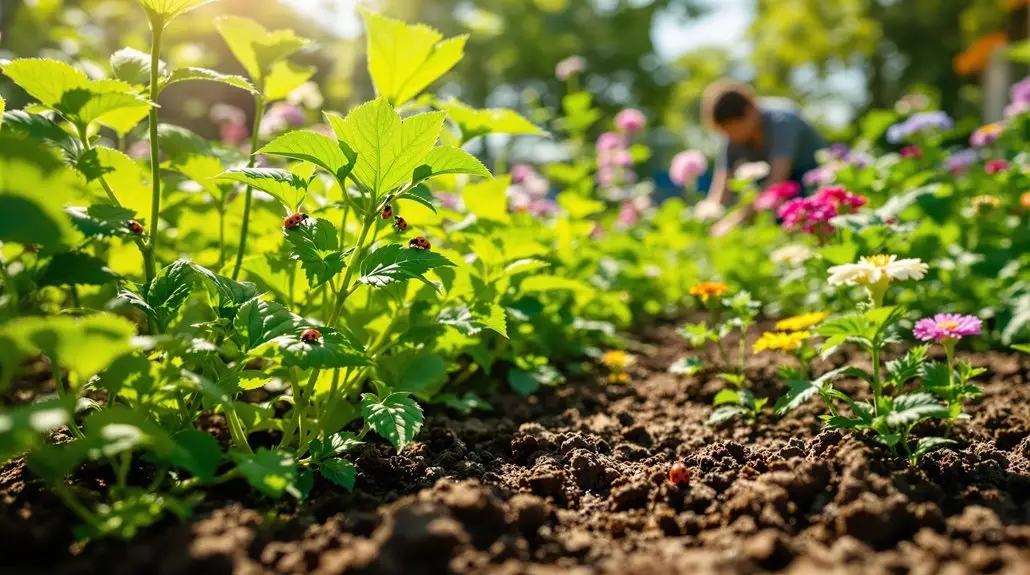
Modifying cultural practices in your garden can greatly enhance plant health and resilience against pests. Start by optimizing your watering and irrigation. Reducing irrigation not only helps mitigate root diseases but also minimizes weed growth. Overwatering can stress your plants, making them more susceptible to pests. Use drip irrigation or soaker hoses to conserve water and reduce pest habitats. Regularly monitor soil moisture to verify you’re not giving your plants too much water.
Next, focus on appropriate fertilization. Maintaining a balanced approach prevents stress from too little or too much fertilizer. Excessive fertilization can lead to rapid growth, making plants more vulnerable to pests. Opt for organic fertilizers that support healthy growth without attracting unwanted visitors. Remember to rotate fertilizers and conduct soil tests to keep track of your garden’s needs.
Don’t overlook mowing and pruning practices. Mow your grass at the recommended height to keep it strong, and prune trees and shrubs selectively to avoid stressing them.
Remove weeds promptly, as they can harbor pests. Trimming bushes and trees helps eliminate pathways for pests to access your home.
Utilizing Physical Barriers
When it comes to protecting your garden from pests, utilizing physical barriers is a practical and effective strategy. You can start by handpicking pests directly from your plants, which not only helps keep your garden healthy but also gives you a chance to connect with nature.
Installing physical screens or fine mesh can prevent unwanted insects from reaching your plants, while row covers work wonders against pests like whiteflies and aphids.
Timing is vital—install barriers at planting time to thwart initial infestations. Regular inspections are important; check for any damage to guarantee your barriers remain effective.
Don’t forget to clean and replace traps regularly to maintain their efficiency. Fastening row covers tightly will help keep pests from sneaking underneath, giving you peace of mind.
In South Florida, you might consider termite barriers around your home or mosquito nets to reduce flying pests. Strategically placing these barriers in areas where pests are most active can make a huge difference.
Remember, integrating these methods with biological and cultural controls enhances your overall pest management strategy.
Using physical barriers not only minimizes the need for chemical pesticides but also shields your family and pets from potential health risks. Plus, they contribute to environmental well-being by safeguarding local wildlife.
Monitoring Pest Activity
After setting up physical barriers to protect your garden, keeping a close eye on pest activity becomes the next vital step. Regular inspections, ideally 1-3 times per week, are essential for catching any pest problems early. Look for signs like chewed or deformed leaves, sooty mold, and ants bustling around your plants.
Don’t forget to check the undersides of leaves and branches, as pests like whitefly nymphs often hide there.
Accurate pest identification is key to effective control. Knowing the life cycles and behaviors of common pests will help you tailor your strategies. Pay attention to symptoms such as discolored plant segments or pest droppings, as these clues guide your approach. Misidentifying a pest can lead to ineffective treatments and harm beneficial organisms in your garden.
Use systematic scouting methods to monitor activity. Visual inspections, traps, and tools like handheld lenses can help you detect populations of pests. Keep a log of your observations to track changes over time, which allows for informed decision-making.
Your monitoring data will inform when to take action. Determine acceptable levels of damage before intervening, considering the type of pest and affected plant. Use both damage and aesthetic thresholds to guide your decisions, especially in ornamental landscapes.
Regularly evaluate the effectiveness of your pest management strategies based on what you’ve observed, ensuring your garden thrives. By staying vigilant, you contribute to a healthy, vibrant landscape for everyone to enjoy.
Climate Adaptation in South Florida
Adapting your garden to South Florida’s unique climate is essential for its long-term success. Start by choosing native and drought-tolerant plants that thrive in the hot, humid conditions of Florida. These plants not only reduce water usage but also lower maintenance costs, allowing you more time to enjoy your garden. Look for varieties that can withstand periods of low rainfall and high heat, ensuring their resilience throughout the season. Additionally, utilizing native and drought-tolerant plants can significantly enhance biodiversity in your landscape.
Efficient water management is key. Water your landscape deeply but infrequently, aiming for about 3/4 to 1 inch of water weekly. Consider installing drip or micro-irrigation systems to deliver water directly to the roots, conserving precious resources. A rain sensor can help, too, shutting off sprinklers when nature provides enough moisture.
When designing your landscape, think about soil type, sunlight exposure, and water availability. Incorporate shading techniques, like planting trees or adding structures, to protect your plants from the intense sun. Regular maintenance, such as pruning trees and shrubs, allows wind to flow through and minimizes damage during storms.
Lastly, enhance your garden’s resilience by choosing Florida-Friendly Landscaping practices. Use plants that improve drainage and can withstand flooding and saltwater intrusion.
Managing Diverse Pest Populations
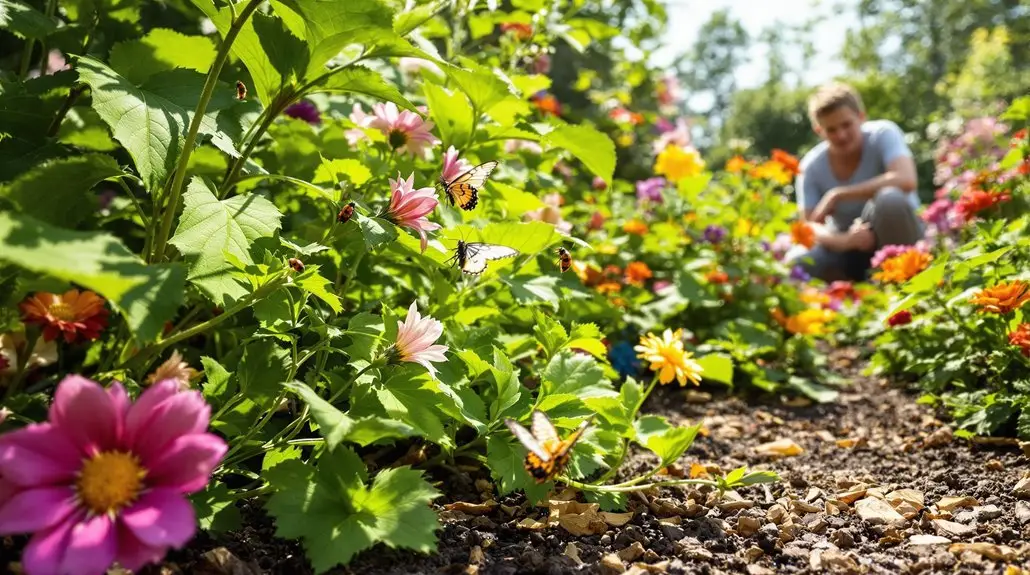
Managing diverse pest populations in your South Florida garden is essential for maintaining plant health and guaranteeing a thriving ecosystem. It’s all about harnessing nature’s balance.
Start by utilizing natural enemies like ladybugs for aphids and larra wasps for mole crickets. These beneficial insects can control pest populations effectively without harmful chemicals. You can also boost their presence through augmentation—by releasing more of these natural predators during peak pest seasons.
Conservation is another critical strategy. Create habitats that attract beneficial insects by providing pollen and nectar sources. For example, planting native flowers helps support local bee populations.
Also, consider using microscopic nematodes to target termite larvae without resorting to chemical treatments.
Cultural practices play a big role too. Choose pest-resistant, native plants and guarantee proper watering and fertilization. This keeps your plants healthy and less prone to infestations.
Crop rotation and intercropping can disrupt pest life cycles, making your garden less inviting to them.
Don’t forget about physical controls. Handpicking larger pests, using barriers like screens, and employing traps can effectively reduce pest numbers.
Regular inspections will help you spot infestations early, allowing you to take action before they escalate.
Tools for Effective IPM
To effectively manage pests, you’ll want to adopt various scouting techniques that help you identify issues early. Utilizing integrated pest management tools will streamline your approach, making it easier to target specific problems. Plus, taking advantage of available educational resources can enhance your understanding and implementation of these strategies. Additionally, understanding the role of natural enemies in your landscape can significantly improve your pest management outcomes.
Scouting Techniques for Pests
Effective pest scouting is essential for successful integrated pest management (IPM) in South Florida’s unique ecosystem. Start scouting as soon as your plants begin to grow or when pests become active, and continue until plants go dormant. Aim for regular checks at least weekly to catch problems early.
Try scouting at different times of the day and even on overcast days to spot subtle symptoms more easily. When inspecting, scan your landscape for any unusual plants and examine them closely. Use systematic patterns like “X” or “W” to cover areas thoroughly, and remember to check both young growth and older leaves, especially their undersides.
Handy tools like a magnifying glass, camera, and pruning shears can aid your inspections. Keep a scouting journal to document your findings, noting dates and symptoms, so you can track changes over time. Use reference materials to help identify pests accurately and correlate their activity with plant growth stages.
Integrated Pest Management Tools
In South Florida, a variety of integrated pest management (IPM) tools can help you tackle pest issues while protecting the environment. By combining cultural, mechanical, biological, and chemical controls, you can create a balanced approach to managing pests in your landscape.
Here’s a quick overview of the tools you can use:
| Control Type | Key Strategies |
|---|---|
| Cultural Control | Use resistant plant varieties, practice crop rotation, and maintain good sanitation. |
| Mechanical Control | Implement barriers, traps, and manual removal of pests. |
| Biological Control | Release natural enemies and provide habitats for beneficial organisms. |
| Chemical Control | Apply pesticides judiciously as a last resort, targeting specific infestations. |
Utilizing these tools not only helps manage pests effectively but also fosters a healthier ecosystem. Remember, the goal is to minimize harm while keeping your landscape thriving. By working together with nature, you’ll create a beautiful environment that you can enjoy for years to come.
Educational Resources Availability
Accessing educational resources is essential for mastering integrated pest management (IPM) in South Florida. You’ll find valuable tools through the University of Florida’s EDIS, which offers detailed publications on IPM principles and practices. These guides help you manage yard pests responsibly while emphasizing biodiversity and ecosystem balance. They even provide examples of biological control methods like using ladybugs and lacewings.
Practical guides and checklists from sources like Sugar Green Gardens can help you prevent pest issues. By placing plants in ideal conditions and regularly observing them, you can catch problems early.
Remember, adopting appropriate watering and fertilization practices is vital for keeping your plants healthy.
Monitoring and identification are key. Regular scouting is recommended, so you can spot signs of pest activity and address them promptly.
Don’t hesitate to reach out for professional support. Companies like Hulett Environmental Services offer tailored IPM services, while local workshops and community programs can deepen your understanding.
Successful Case Studies
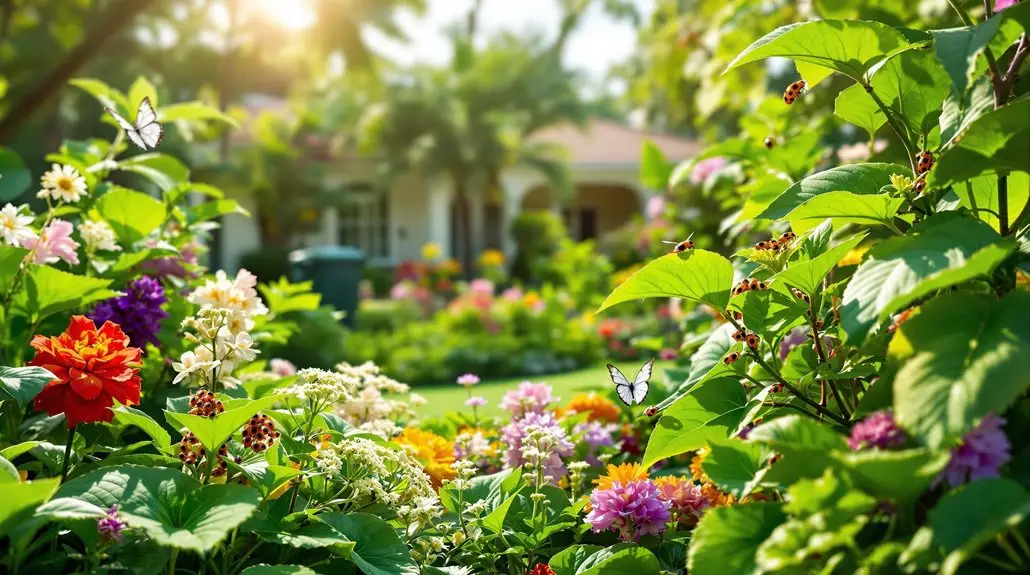
Successful case studies in South Florida demonstrate the power of biological control methods in managing pest populations. You’ll find that many homeowners have successfully implemented these strategies, leading to healthier gardens and reduced reliance on chemicals. For instance, ladybugs and lacewings have been introduced to control aphids and whiteflies, keeping these pests in check while enhancing the ecosystem.
Here are some key highlights from these successful cases:
- Natural Predators: Ladybugs and dragonflies effectively reduce pest populations without harming beneficial insects.
- Parasitic Wasps: The larra wasp, introduced from South America, targets mole crickets, providing a natural solution to a common problem.
- Seasonal Releases: Homeowners release ladybugs and lacewings seasonally, boosting natural predator populations at critical times.
- Cultural Practices: Techniques like crop rotation and reduced irrigation create unfavorable conditions for pests, supporting biological control efforts.
- Habitat Enhancement: Planting diverse vegetation attracts beneficial insects, enhancing the natural balance in gardens.
Adopting these biological control methods not only fosters a thriving garden but also builds a sense of community among those who share your passion for sustainable landscaping.
Promoting Biodiversity in Landscapes
Promoting biodiversity in your landscape not only enhances its beauty but also creates a thriving ecosystem that supports beneficial organisms. By selecting a variety of plants with different colors, structures, and bloom times, you can attract essential insects and wildlife. Native plants often resist pests better than exotic varieties, making them a smart choice for your garden.
Here’s a simple guide to help you enhance biodiversity in your landscape:
| Strategies | Benefits |
|---|---|
| Choose diverse plants | Attracts a range of beneficial insects |
| Incorporate habitat features | Provides shelter for beneficial organisms |
| Use native plants | Reduces pest vulnerability and maintenance |
Consider intercropping vegetables with flowering plants like sweet alyssum to draw in hoverflies, which prey on aphids. You’ll also want to provide nectar and pollen sources for insects like the larra wasp. Avoid excessive pesticide use, as it can harm these beneficial insects. Instead, focus on enhancing habitats that promote their populations.
Regular monitoring and maintenance will help you keep your garden healthy. Observe your plants for early signs of pests and maintain proper watering and fertilization practices. By creating a supportive environment, you not only foster a vibrant ecosystem but also cultivate a sense of community with nature. Your efforts will lead to a more sustainable landscape where both you and the beneficial organisms can thrive together.
Frequently Asked Questions
How Long Does It Take for Biological Control Methods to Show Results?
When you use biological control methods, you can see results in a few weeks to a few months, depending on the pest.
For instance, if you release ladybugs to tackle aphids, you might notice a difference in just 2-4 weeks.
However, some agents, like nematodes for termites, may take 1-3 months.
Early detection and ongoing monitoring are key to ensuring these methods work effectively for your landscape over time.
Are There Any Risks Associated With Introducing Natural Enemies?
Yes, there are risks when introducing natural enemies. You might face unintended consequences, like these enemies becoming invasive themselves.
They can disrupt local ecosystems, affecting beneficial species too. Also, relying solely on biological control could lead to neglecting other significant pest management strategies.
Plus, new agents may pose health risks for sensitive individuals. It’s essential to weigh these risks carefully and consider a balanced approach for effective pest management.
Can Biological Control Methods Be Used Alongside Chemical Treatments?
Yes, you can definitely use biological control methods alongside chemical treatments!
By combining these approaches, you enhance your pest management effectiveness while reducing the reliance on chemicals. This strategy not only helps protect beneficial organisms but also creates a more balanced ecosystem.
When you integrate both methods, you’ll likely find that your pest control becomes more sustainable and cost-efficient, making your landscape healthier and more vibrant for everyone to enjoy.
What Are the Costs Associated With Implementing Biological Control?
Implementing biological control can feel like climbing Mount Everest!
You’ll face initial costs like establishing hedgerows or buying agents, which can add up fast. Ongoing maintenance, like regular monitoring and plant care, also contributes to expenses.
However, the long-term benefits, such as reduced pesticide costs and enhanced biodiversity, can make this journey worthwhile.
How Can Homeowners Learn More About Specific Biological Control Techniques?
You can learn more about specific biological control techniques by tapping into various resources.
Check out local extension services for expert advice, or join community workshops to connect with others interested in pest management.
Online guides and blogs can offer practical tips, too.
Don’t forget to consult professional pest control services specializing in biological methods.
Engaging with your community won’t only expand your knowledge but also foster a supportive network of fellow homeowners.
Cultivate a Thriving Garden: Harness Biological Control with NaturePest Holistic Pest Control!
Incorporating biological control into your South Florida landscape not only curbs pests but also promotes a thriving ecosystem. Remember, “a stitch in time saves nine”—by adopting these strategies early, you’re setting the stage for a healthier garden. Embrace the diversity of natural enemies and implement effective IPM tools to keep your plants flourishing.
At NaturePest Holistic Pest Control, we are dedicated to helping you create a harmonious environment that benefits both your landscape and the local ecosystem. Don’t wait—take action today and let us assist you in cultivating a vibrant garden for a brighter tomorrow! Contact NaturePest now to learn more about our holistic pest control solutions.

